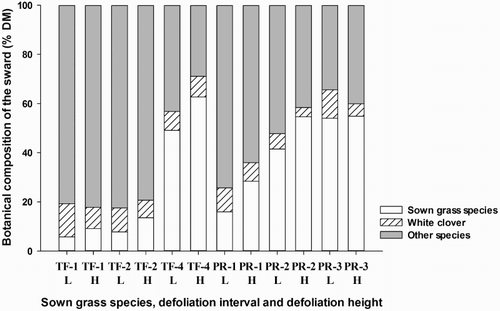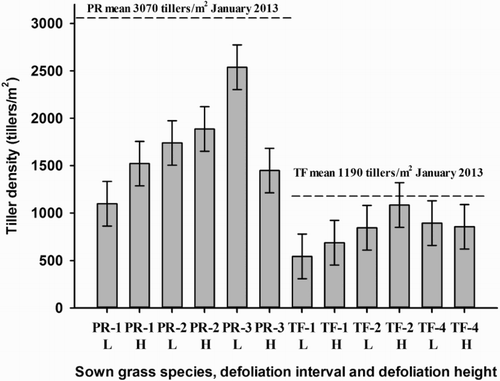Figures & data
Table 1. Defoliation events of tall fescue (TF) and perennial ryegrass (PR) plots subjected to different defoliation intervals (one-leaf stage, -1; two-leaf stage, -2; three-leaf stage, -3; four-leaf stage, -4) during the experimental period.
Table 2. Available dry matter (DM) yield and cumulative DM yield (kg DM/ha) of tall fescue (TF) and perennial ryegrass (PR).
Table 3. Available dry matter (DM) yield and cumulative DM yield (kg DM/ha) of tall fescue (TF) and perennial ryegrass (PR) subjected to defoliation at different defoliation intervals (one-leaf stage, -1; two-leaf stage, -2; three-leaf stage, -3; four-leaf stage, -4) during the experimental period.
Figure 1. Effect of defoliation interval (one-leaf stage, -1; two-leaf stage, -2; three-leaf stage, -3; four-leaf stage, -4) and sown grass species (TF, tall fescue; PR, perennial ryegrass) on the botanical composition (%DM, dry matter) of the sward during year 2 (27 May 2014). The standard error bars are 8.3% for sown grass species, 1.2% for white clover and 7.5% for other species.

Figure 2. Effect of leaf stage (one-leaf stage, -1; two-leaf stage, -2; three-leaf stage, -3; four-leaf stage, -4), defoliation height; low (L, 5 cm) and high (H, 8 cm) and sown grass species (TF, tall fescue; PR, perennial ryegrass) on the botanical composition (%DM, dry matter) of the sward at the end of the experimental period (October/November 2014; year 2). The standard error bars are 5.8% for sown grass species, 0.7% for white clover and 5.7% for other species.

Table 4. Herbage quality values (metabolisable energy, ME; crude protein, CP%) of tall fescue (TF) and perennial ryegrass (PR) subjected to different defoliation intervals (one-leaf stage, -1; two-leaf stage, -2; three-leaf stage, -3; four-leaf stage, -4.
Figure 3. Tiller density (tillers/m2) of tall fescue (TF) and perennial ryegrass (PR) plots under two defoliation heights (low, 5 cm, L; high, 8 cm, H) and subjected to defoliation at different defoliation intervals (one-leaf stage, -1; two-leaf stage, -2; three-leaf stage, -3; four-leaf stage, -4) at the end of the experiment (vertical columns) (October/November 2014). Horizontal dotted lines represent the tiller densities at the commencement of the experiment (January 2013). The standard error bars represent standard errors at P < 0.05.

